(2 pm. – promoted by ek hornbeck)
Crossposted at Daily Kos and Docudharma
|
|
|
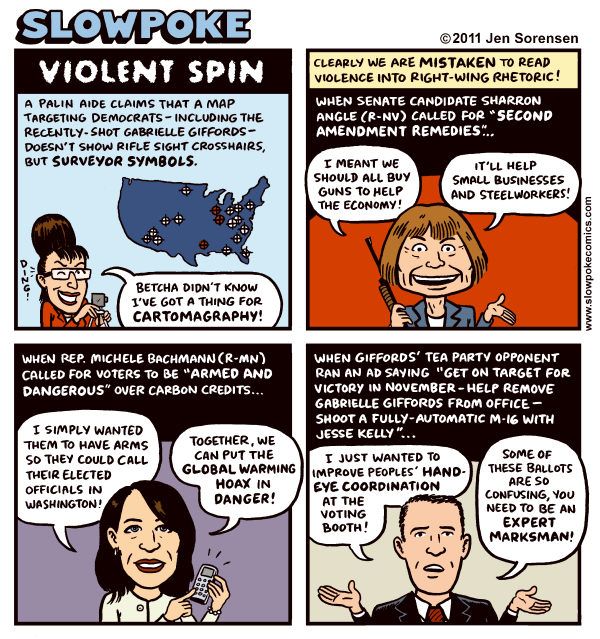
Jen Sorensen, Slowpoke, Buy this cartoon
:: ::
Sorensen writes on her blog:
What really drives me nuts in the wake of the Giffords shooting is the chorus of voices — mostly on the right — tut-tutting that “we can’t jump to conclusions.” As though they are the source of caution and reason and all things prudent and high-minded. Well, guess what: your candidates are anything but. I don’t really care whether Loughner is schizo, or what particular bits of tea party propaganda he swallowed or didn’t. If you don’t find the violent language of the right utterly repugnant, then it’s a sign of how far we’ve drifted away from normalcy in this country.
|
|
|
|
|
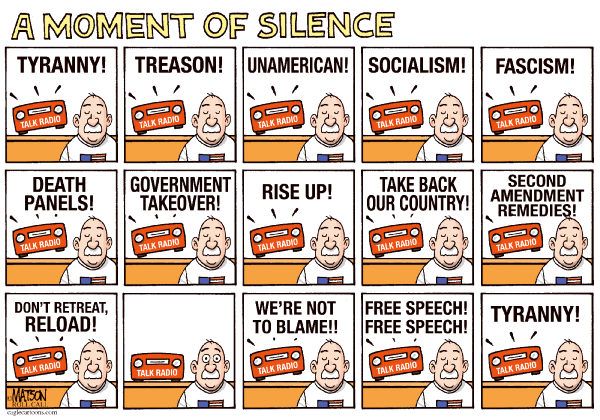
Moment Of Silence by RJ Matson, Roll Call, Buy this cartoon

Drew Sheneman, Comics.com (Newark Star-Ledger)
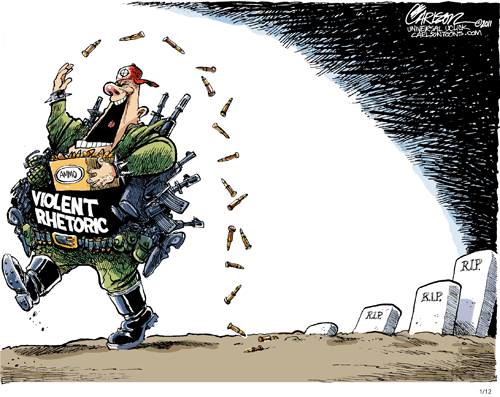 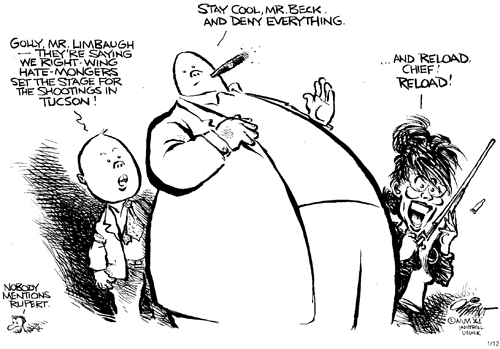
Stuart Carlson, Washington Post/Universal Press Syndicate and Pat Oliphant, Washington Post/Universal Press Syndicate
(click links to enlarge cartoon)

Vic Harville, Stephens Media Group, Buy this cartoon
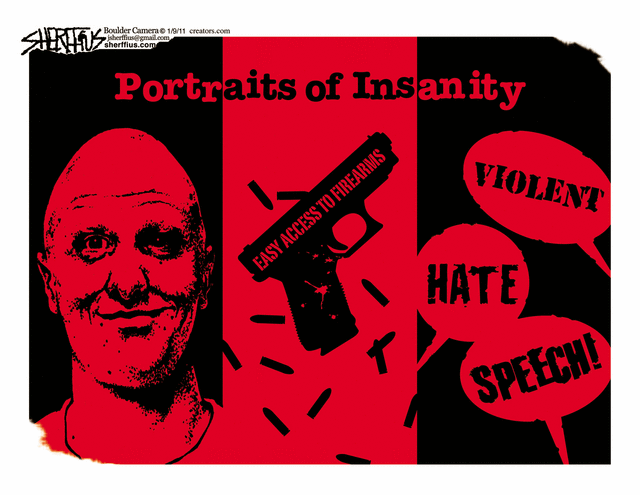
John Sherffius, Comics.com (Blouder Daily Camera)
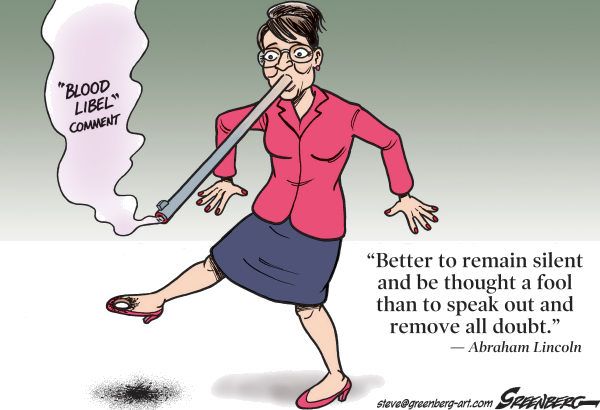
Palin Blood Libel by Steve Greenberg, Freelance Cartoonist (Los Angeles), Buy this cartoon
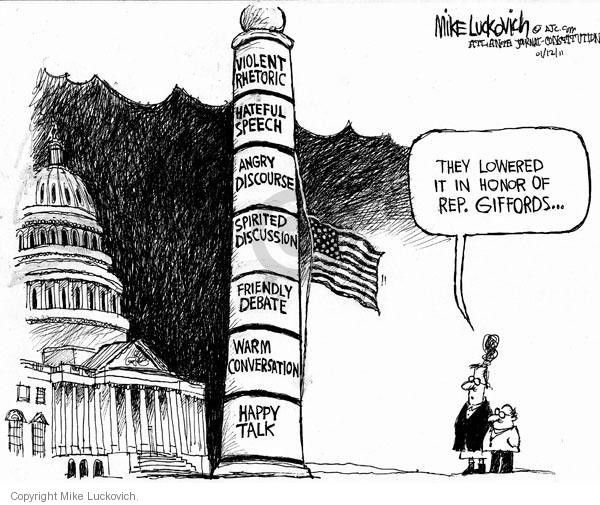
Mike Luckovich, Comics.com (Atlanta Journal-Constitution)
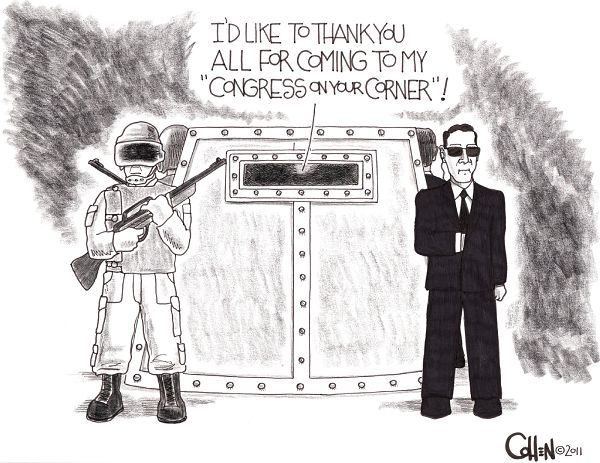 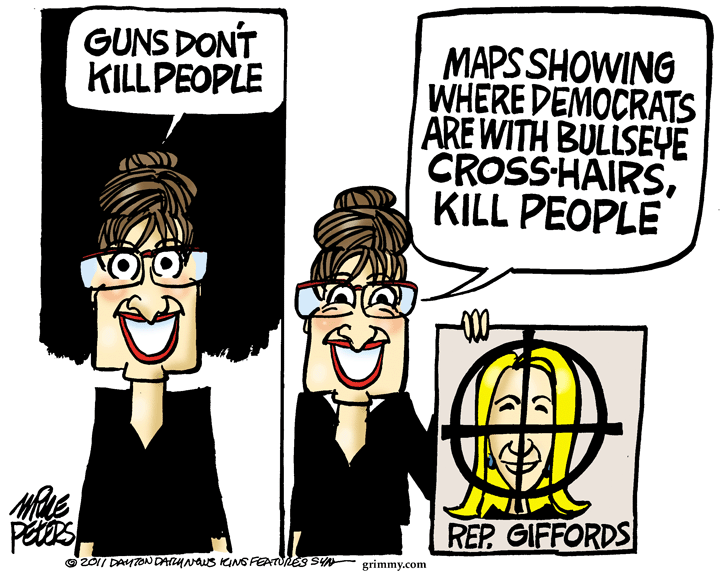
Bunker Down by David Cohen, Asheville Citizen-Times and Mike Peters, Dayton Daily News
(click link to enlarge cartoon)
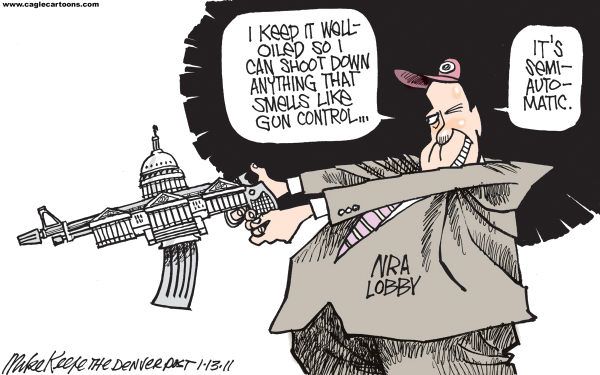
Gun Control by Mike Keefe, Denver Post, Buy this cartoon
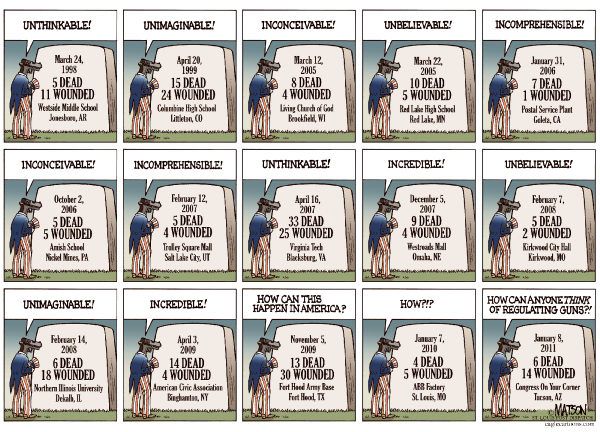
Guns and the Unthinkable by RJ Matson, St. Louis Post Dispatch, Buy this cartoon
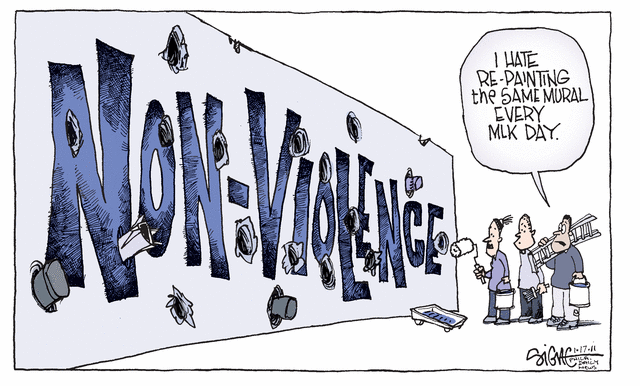
Signe Wilkinson, Comics.com (Philadelphia Daily News)
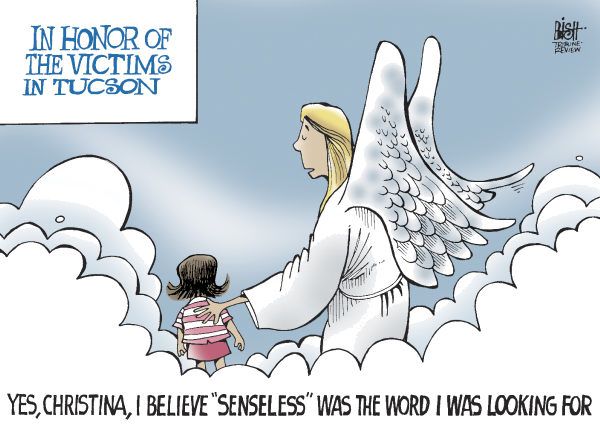
Tucson Victims by Randy Bish, Pittsburgh Tribune-Review, Buy this cartoon
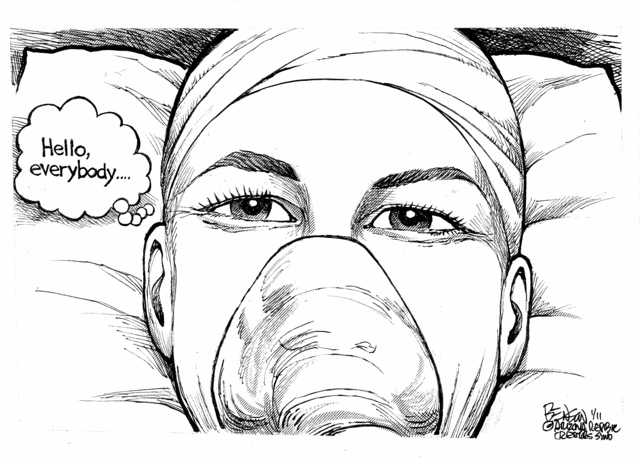
Steve Benson, Comics.com (Arizona Republic)
:: ::
Amidst all the madness around us, a glimmer of hope as Congresswoman Gabrielle Giffords’ condition continues to improve and the City of Tucson held a Walk for Peace earlier today
U.S. Rep. Gabrielle Giffords continues her recovery from a gunshot wound to the head and is able to move both sides of her body, a senator who is a friend of the lawmaker said on Sunday.
Speaking on NBC’s “Meet the Press,” Sen. Kirsten Gillibrand (D-N.Y.) said she had talked with Giffords’ husband, Mark Kelly, on Saturday night. The astronaut described the latest progress in his critically injured wife’s recovery after the Jan. 8 shooting.
“She’s making progress every day,” Gillibrand said. “She’s using both sides of her body. She’s able to breathe on her own. She’s able to open her eyes and to show people she understands what she’s hearing and seeing. So… it’s an extraordinary amount of progress for a woman who sustained such a horrific injury that she did.”
|
|
:: ::
THE WEEK IN EDITORIAL CARTOONS
This weekly diary takes a look at the past week’s important news stories from the perspective of our leading editorial cartoonists (including a few foreign ones) with analysis and commentary added in by me.
When evaluating a cartoon, ask yourself these questions:
1. Does a cartoon add to my existing knowledge base and help crystallize my thinking about the issue depicted?
2. Does the cartoonist have any obvious biases that distort reality?
3. Is the cartoonist reflecting prevailing public opinion or trying to shape it?
The answers will help determine the effectiveness of the cartoonist’s message.
:: ::
INTRODUCTION
:: ::
An Appeal to the “Better Angels of Our Nature”
Among developed democratic countries, the United States is the only country where the President is not only the head of government but also the head of the nation. Under the best of circumstances, it is a tricky balancing act for the President cannot be seen as exploiting moments of triumph or tragedy for the nation to his political advantage. And, yet, given that the two roles are merged, there is undoubtedly a political dimension. As I listened last Wednesday night to President Barack Obama deliver his moving and eloquent tribute to the victims of this senseless tragedy in Tucson, Arizona my mind drifted back to the mid-1990’s when I lived in England attending one of my graduate schools.
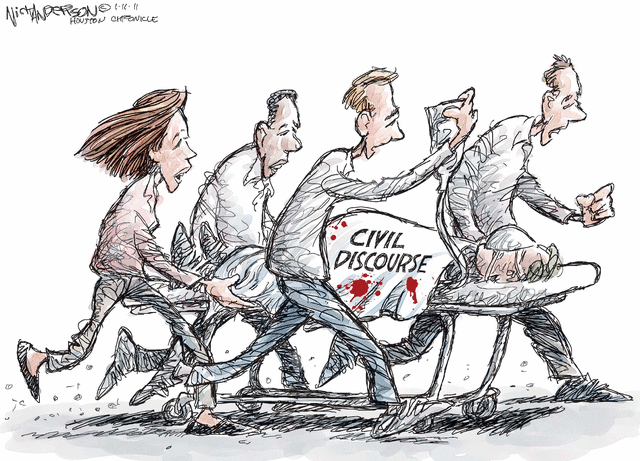
(Critical Condition by Nick Anderson, Comics.com, see the large number of reader comments in the Houston Chronicle)
I often used to engage my classmates from other countries in vigorous debate about the many seeming contradictions that define what it means to be an American. It is what one does as a student. It is how you compare and contrast yourself to others. It is how you learn about your strengths, shortcomings, and inadequacies. No matter the number of years spent in school studying the great issues of the day and even as one learns about other countries, cultures, and traditions, the greater the realization how little one really knows. It can be a humbling experience.
These arguments in grad school included, for example, many diverse topics such as, why do individuals have so many rights in America? Are millions of guns really necessary in what supposedly is an enlightened and developed society? Why do Americans tolerate so much inequality of wealth and income? And, on and on. And even as they questioned so many of these features of American life, most of them were quite interested in moving here and working in, as a German classmate of mine once told me, the “most egalitarian country” in the world. Quite a few had done internships in the U.S. Congress, studied in American universities, and visited friends and relatives in America. No matter where they hailed from — and they were from every corner of the world — many have a cultural affinity for this country. It is a claim few other countries, if any, could legitimately make with any sort of historical justification. We are in many ways the world’s cultural melting pot.
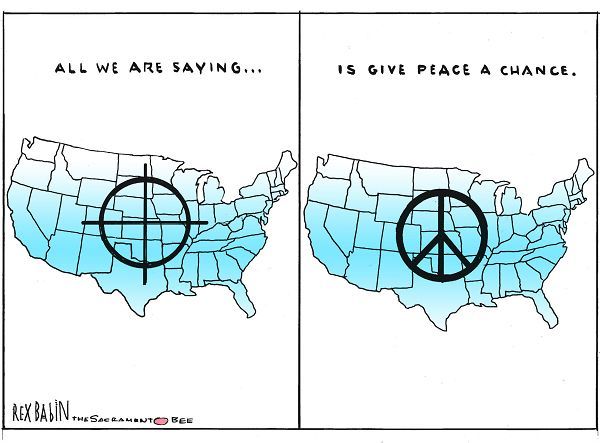
(Rex Babin, McLatchy Cartoons/Sacramento Bee, click link to enlarge cartoon)
My response to these pointed questions was to frequently state that just like this vast, complex, sprawling, and pluralistic country, the American character is full of irreconcilable contradictions. Equality of opportunity and fairness for all are, to cite two societal goals, what this country strives for but even as it professes through its founding documents to keep hoping for a “more perfect union” it, often, has failed to live up to its ideals. And, yet, perhaps more than any other country in the world, it remains a magnet for other people seeking a better life. It is often said that you can permanently move to, say France or Germany, but perhaps never actually become French or German. Some things take generations to achieve. You can indeed migrate to this country and largely succeed in becoming an American. There are millions of examples of such transformations all around us in our cities and suburbs.
One of the best examples of this “contradictory” nature of this country was a monologue first delivered in 1975 by the late George Carlin in which he compared the two most popular of American sports, baseball and football. As Carlin brilliantly elucidates, the two sports not only embody some of our values but capture the emotions that so many of us periodically experience. It touches upon several of the themes that define our daily lives: peace vs aggression; complexity vs simplicity; individual success vs collective failure; serenity vs turmoil; ambition vs contentment; certainty vs uncertainty; aggression vs pacifism; patience vs impatience; and reason vs irrationality. In some respects, you could say that in his routine, Carlin compares our inner Locke to our outer Hobbes in discussing these two very different sports. And how we, as humans, reconcile these many contradictory impulses.

George Carlin Obit by Mike Keefe, Denver Post, Buy this cartoon
:: ::
Baseball & football are the two most popular spectator sports in this country. And as such, it seems they ought to be able to tell us something about ourselves and our values.
I enjoy comparing baseball and football:
Baseball is a nineteenth-century pastoral game.
Football is a twentieth-century technological struggle.
Baseball is played on a diamond, in a park. The baseball park!
Football is played on a gridiron, in a stadium, sometimes called Soldier Field or War Memorial Stadium.
Baseball begins in the spring, the season of new life.
Football begins in the fall, when everything’s dying.
In football you wear a helmet.
In baseball you wear a cap.
Football is concerned with downs – what down is it?
Baseball is concerned with ups – who’s up?
In football you receive a penalty.
In baseball you make an error.
In football the specialist comes in to kick.
In baseball the specialist comes in to relieve somebody.
Football has hitting, clipping, spearing, piling on, personal fouls, late hitting and unnecessary roughness.
Baseball has the sacrifice.
Football is played in any kind of weather: rain, snow, sleet, hail, fog…
In baseball, if it rains, we don’t go out to play.
Baseball has the seventh inning stretch.
Football has the two minute warning.
Baseball has no time limit: we don’t know when it’s gonna end – might have extra innings.
Football is rigidly timed, and it will end even if we’ve got to go to sudden death.
In baseball, during the game, in the stands, there’s kind of a picnic feeling; emotions may run high or low, but there’s not too much unpleasantness. In football, during the game in the stands, you can be sure that at least twenty-seven times you’re capable of taking the life of a fellow human being.
And finally, the objectives of the two games are completely different:
In football the object is for the quarterback, also known as the field general, to be on target with his aerial assault, riddling the defense by hitting his receivers with deadly accuracy in spite of the blitz, even if he has to use shotgun. With short bullet passes and long bombs, he marches his troops into enemy territory, balancing this aerial assault with a sustained ground attack that punches holes in the forward wall of the enemy’s defensive line.
In baseball the object is to go home! And to be safe! – I hope I’ll be safe at home!
:: ::
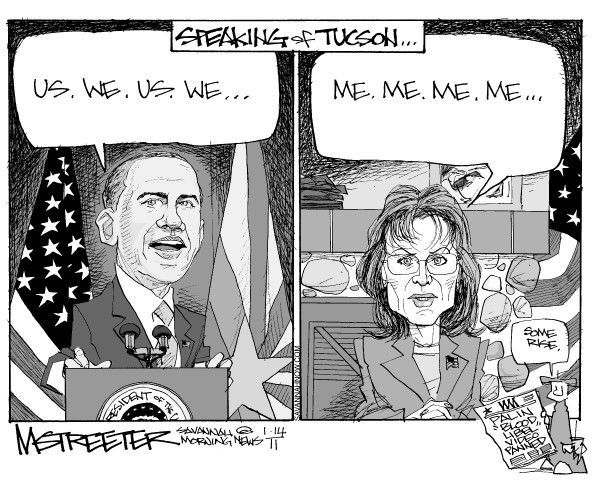
Mark Streeter, Savannah Morning News, Buy this cartoon
:: ::
Following the best examples of the Reverend Martin Luther King, Jr.’s life — whose accomplishments and many sacrifices of behalf of all Americans we celebrate today — President Barack Obama appealed for calm and civility. We expect our leader to embody our most-cherished values as a nation. In what may have been his best speech ever, he passed the test with flying colors — as contrasted to the pathetic response from his political opponents in the past few days.
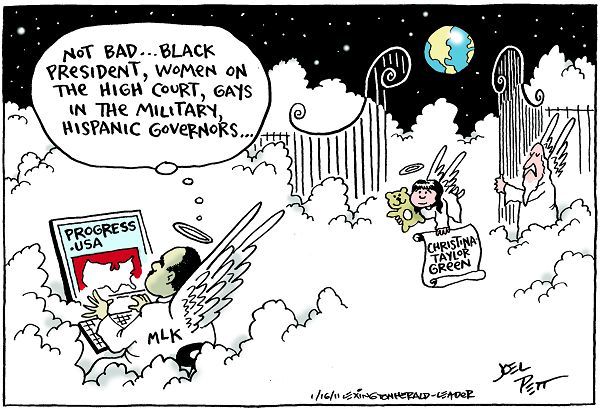
(Joel Pett, McLatchy Cartoons/Lexington Herald-Leader, click link to enlarge cartoon)
Befitting the moment, the President only briefly alluded to the many different aspects of this senseless tragedy. Editorial cartoonists, however, used their platforms to explore different issues that have come to the fore in the past week. What are the limits of acceptable political speech and the role of the opposition party? How should ordinary citizens and their Congressional representatives behave in times like these? Is it the prevalence of guns or mental illness that results in such horrific murders? This diary explores all these questions through the brilliant graphical illustrations of our leading editorial cartoonists. It is interesting to note that foreign editorial cartoonists — not unlike many of my former classmates in England — took a much harsher approach for they cannot understand why we, as a country, allow guns to cause so much violence and carnage every year.
Will the President’s call for civility result in a kinder and gentler approach by all participants in coming weeks and months? He did his job. Will all of us do the same? Given our violent history, I am afraid that won’t be the case.
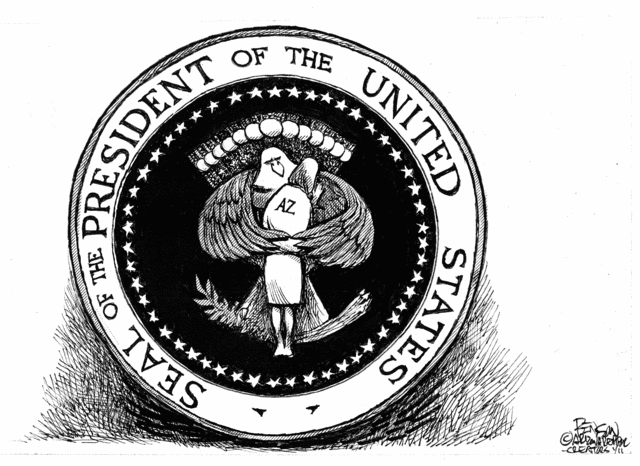
Steve Benson, Comics.com (Arizona Republic)
:: ::
2. The Incredibly Shrinking Sarah Palin
:: ::
Bors dismatles the arguments often made by wingnuts which assert that irresponsible political rhetoric has no effect on our political culture
Lone Nuts
I don’t think Palin or the Tea Party is directly responsible for inspiring this massacre in Arizona. But there’s a reason she scrubbed her website, deleted tweets, and had surrogates argue that those weren’t targets on her map, but “surveyor’s marks.” That she has to insult us with these lies is telling. It’s not that she feels guilty — it’s that she’s so self-absorbed she thinks she’s a victim here for being called to answer for her rhetoric.
There’s a certain amount of war rhetoric that goes into campaigning. I’m not in favor of being overly sensitive about these things to the point where you can’t use a colorful metaphor. But we saw a health care reform debate and then an election where people were openly carrying guns, talking about watering the tree of liberty with blood and using “second amendment remedies” for Senators. A sheriff steps over the dead bodies in his town to mention these things might be inappropriate and he’s the one being blasted for making inappropriate comments.
And that’s where we are at. You can’t talk about the issues underneath this without being accused of “politicizing” it. The shooter is crazy and incoherent enough that we can all comfortably write him off as a “lone nut,” America’s favorite term to absolve us from looking at any of the societal problems that causes this type of behavior — or, god forbid, the tools he used to kill so many so fast. Unless the shooter fits into the binary mold of a mainstream liberal or conservative, we are content to pretend his behavior took place in a vacuum. “A lone nut! you’ll get those.”
And we will. See you back here next massacre.
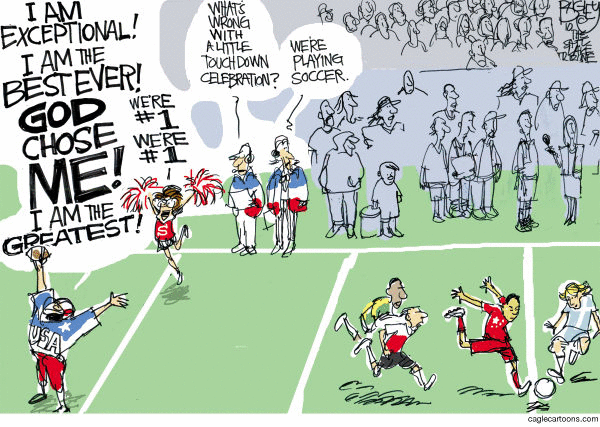
American Exceptionalism by Pat Bagley, Salt Lake Tribune, Buy this cartoon
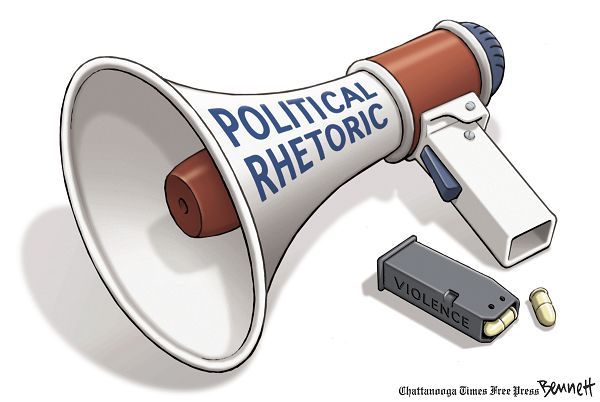
The Bullhorn by Clay Bennett, Comics.com, see the large number of reader comments in the Chattanooga Times Free Press
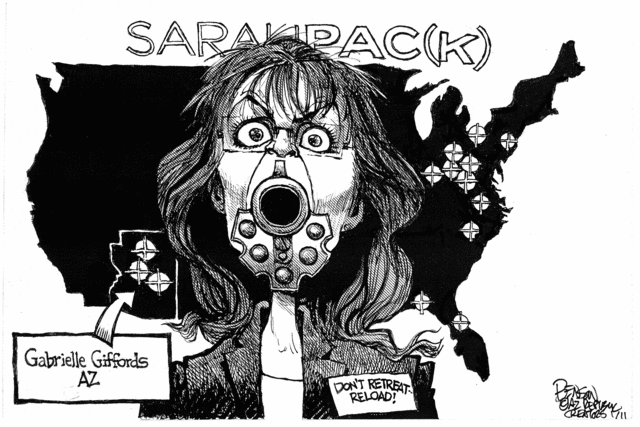
Steve Benson, Comics.com (Arizona Republic)

Lalo Alcaraz, LA Weekly, Buy this cartoon
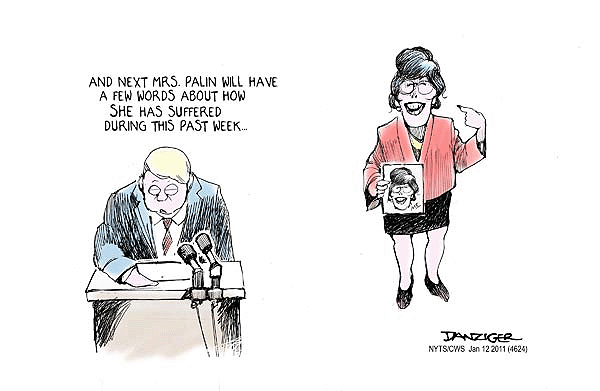
Jeff Danziger, Yahoo Comics/New York Times Syndicate
(click link to enlarge cartoon)

Palin Explains by Randall Enos, Cagle Cartoons, Buy this cartoon

Jeff Darcy, Cleveland Plain-Dealer, Buy this cartoon
:: ::
3. Does the Republican Party Stand For Anything?

John Sherffius, Comics.com (Boulder Daily Camera)
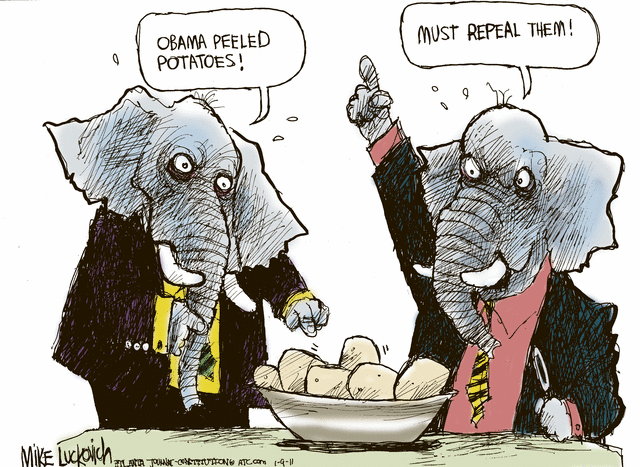
Mike Luckovich, Comics.com (Atlanta Journal-Constitution)
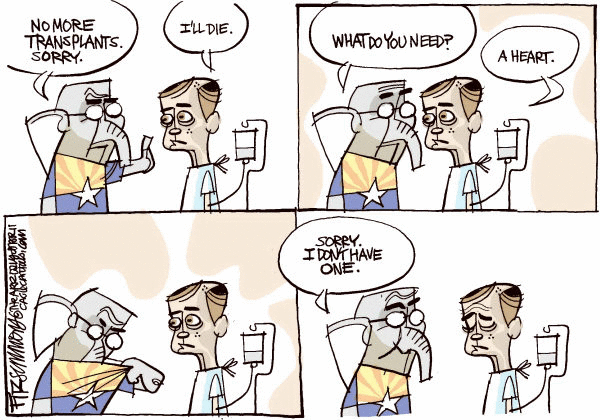
Arizona Transplants by David Fitzsimmons, Arizona Star, Buy this cartoon

Rhetorical Civility by Pat Bagley, Salt Lake Tribune, Buy this cartoon
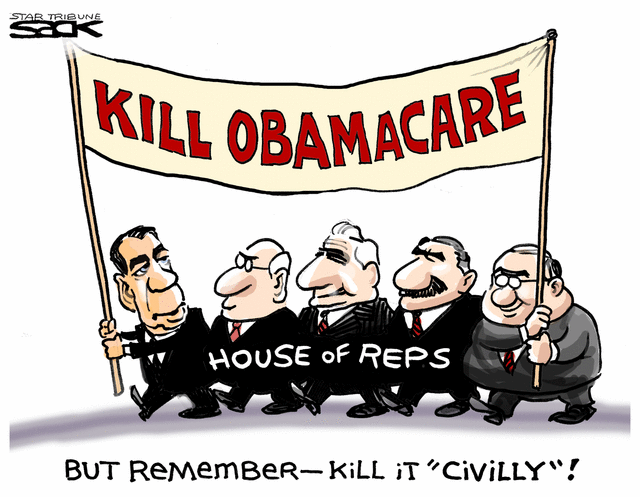
Steve Sack, Comics.com (Minneapolis Star-Tribune)

Obama Kenyanese by Pat Bagley, Salt Lake Tribune, Buy this cartoon
:: ::
4. A Culture of Guns and Violence
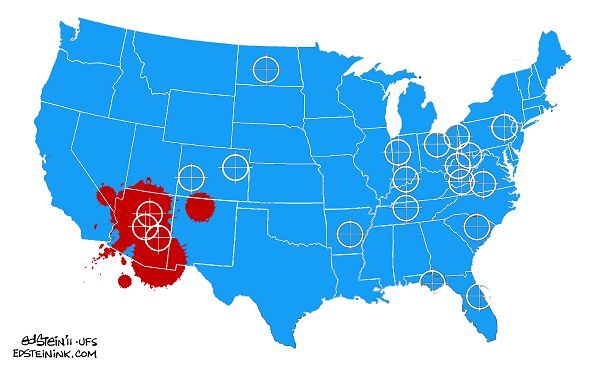
Ed Stein, Comics.com (formerly of the Rocky Moutain News), see reader comments on Stein’s blog
:: ::
Stein points the finger in the direction of those who carelessly throw around code words and then absolve themselves of all consequences
It now appears that Representative Gabrielle Giffords was the target of an assassination plot. The reasons are unknown, and it’s too early to claim categorically that the shooting of Ms. Giffords and the other victims was motivated by a political grievance. That said, it’s not hard to believe that the poisonous political climate of the last few years can move an unstable person to violence. Indeed, the past summer, featuring rage-filled shoutdowns at town hall meetings, gleefully promoted by Fox News and conservative talk show hosts, led to hundreds of threats against members of Congress. The poster symbol of the anger and intolerance may well be the map Sarah Palin posted on her website during the election, highlighting targeted Democratic congressional districts with crosshairs…
Now, of course, the same folks who gloried in the over-the-top rhetoric, who infused the political debate with violent imagery, are shocked at the bloodshed. I’d like to believe that this event will force us all to reconsider how we conduct the political discourse in this country, but I suspect that, after a brief pause, we will go on as before. Too many pundits make their living stoking the public rage, and too many politicians have learned to capitalize on that anger. The mainstream politicians all responded with appropriate horror and sadness (as well they should, given the danger they are all exposed to), as did many of the Tea Party leaders. Then there was Judson Phillips, founder of the Tea Party Nation, whose immediate response to the carnage was this: “The hard left is going to try and silence the Tea Party movement by blaming us… the shooter was a liberal lunatic. Emphasis on both words.”
So much for soul-searching.
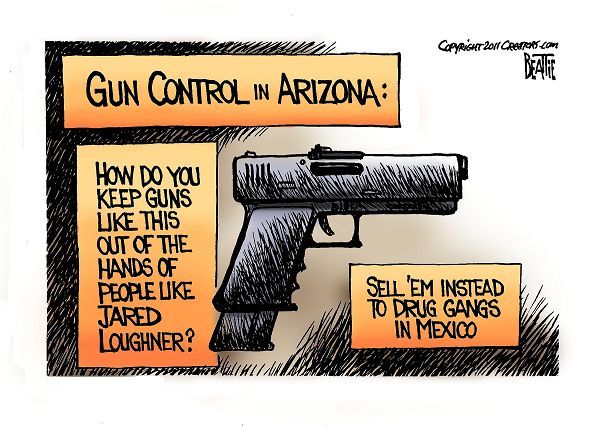
Bruce Beattie, Comics.com (Daytona Beach News-Journal)
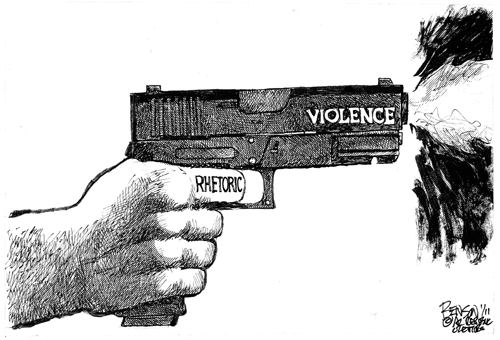
Steve Benson, Comics.com (Arizona Republic)

Gun Culture by Cam Cardow, Ottawa Citizen, Buy this cartoon

After The Arizona Killing by Patrick Chappatte, International Herald Tribune, Buy this cartoon
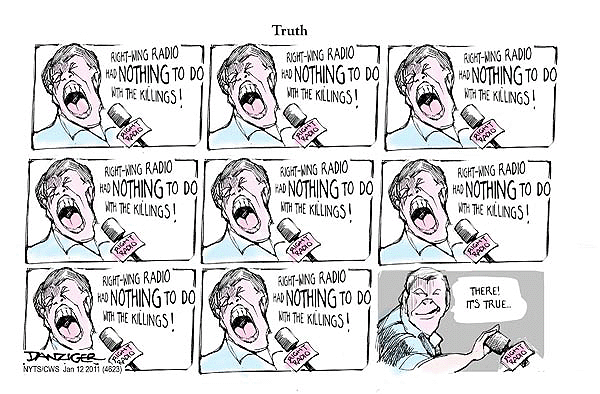
Jeff Danziger, Yahoo Comics/New York Times Syndicate
(click link to enlarge cartoon)
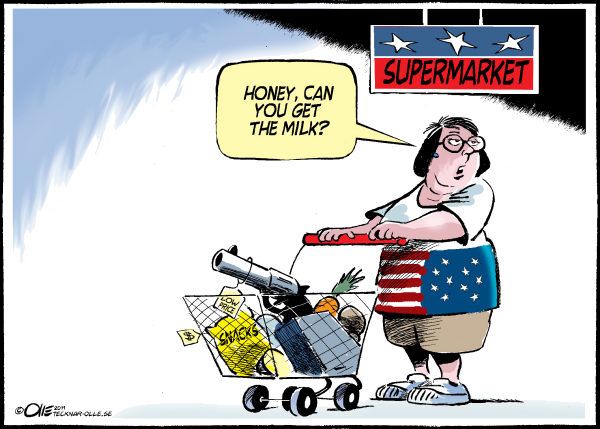
Too Easy to Buy a Gun by Olle Johansson (Sweden), Buy this cartoon
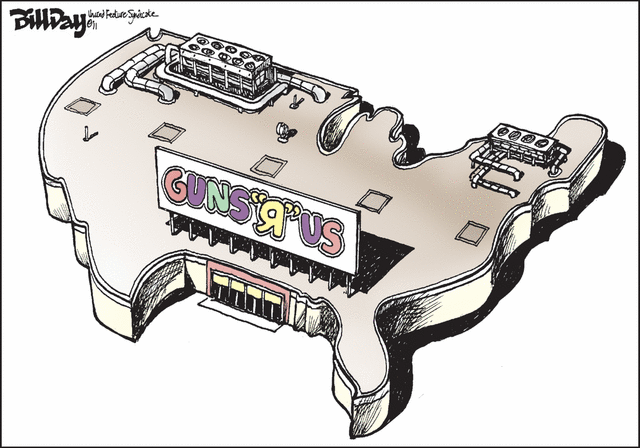
Bill Day, Comics.com (Memphis Commercial-Appeal)
:: ::
5. The National Rifle Association and the U.S. Congress
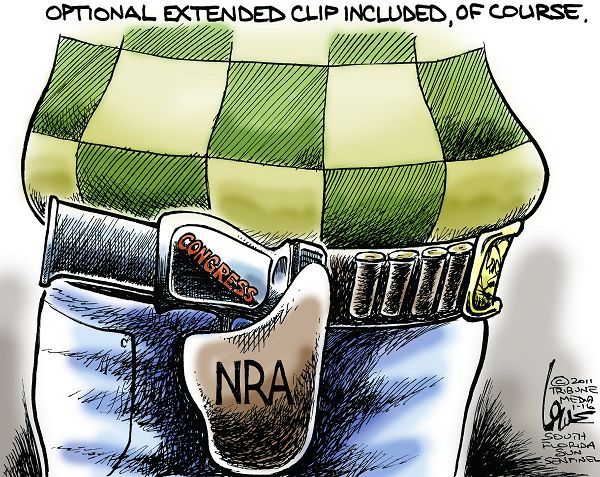
Congress Caves to the NRA by Chan Lowe, Comics.com (South Florida Sun-Sentinel)
:: ::
In spite of this terrible tragedy, Lowe is not very optimistic that sensible gun laws will be enacted
Since this has turned into Gun Theme Week, I don’t have much more to say beyond my discourse of a couple of days ago, except that if you are one of those people who worry about the tyranny of our federal government, you can stand down.
As long as the NRA exists, with its awesome fundraising power and ability to turn out single-issue voters when it counts, congresspersons of both parties will quake and cower.
Yes, our representatives and senators know that there is no justifiable need for extended clips. They know that assault rifles are an invitation to mayhem, but they also have a highly-developed sense of self-preservation that, sadly, overwhelms any impulse to do what’s best for their country.
You want to talk tyranny? It’s as clear as the view through your telescopic sight.

Gun Almighty by Pat Bagley, Salt Lake Tribune, Buy this cartoon

Poster Boy by Aislin, Montreal Gazette, Buy this cartoon

NRA Discipline by Pat Bagley, Salt Lake Tribune, Buy this cartoon
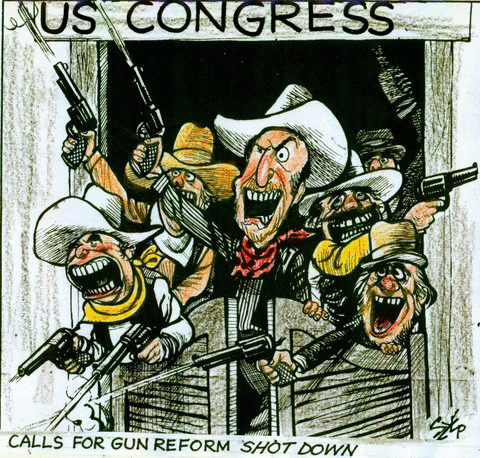
Paul Szep, Comics.com

Democracy in the Crosshairs by John Darkow, Columbia Daily Tribune, Buy this cartoon
:: ::
7. Access to the Treatment of Mental Illnesses
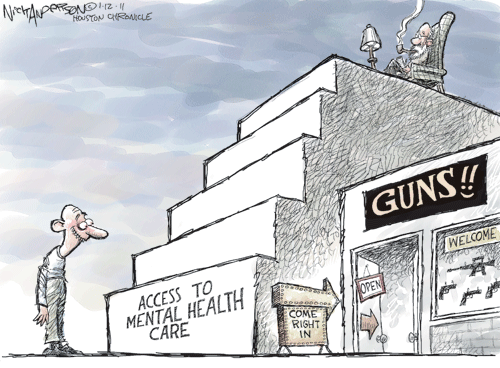
Easy Access by Nick Anderson, Comics.com, see reader comments in the Houston Chronicle)
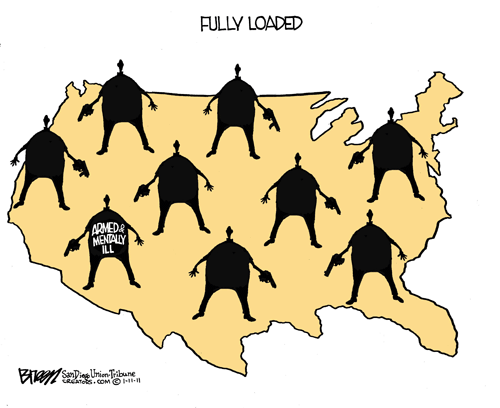
Steve Breen, Comics.com (San Diego Union-Tribune)

Jeff Koterba, Omaha World Herald, Buy this cartoon

Tuscon Shooting by Mike Keefe, Denver Post, Buy this cartoon
:: ::
8. The Victims of the Tucson Tragedy
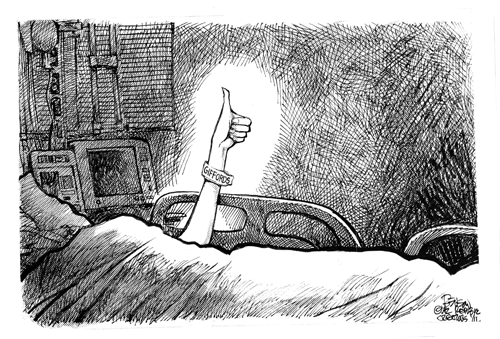
Steve Benson, Comics.com (Arizona Republic)

Rex Babin, Sacramento Bee, Buy this cartoon

Live Up to Her by Nate Beeler, Washington Examiner, Buy this cartoon
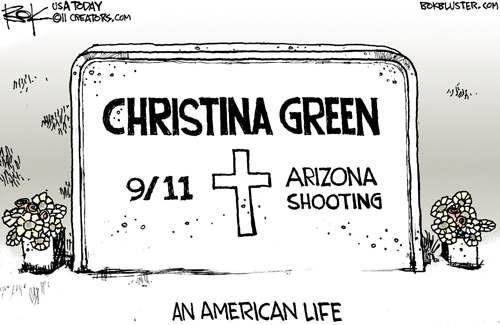
Chip Bok, Comics.com

Sheriff Dupnik by David Fitzsimmons, Arizona Star, Buy this cartoon

Tucson Shooting Victims Tribute by Dave Granlund, Politicalcartoons.com, Buy this cartoon
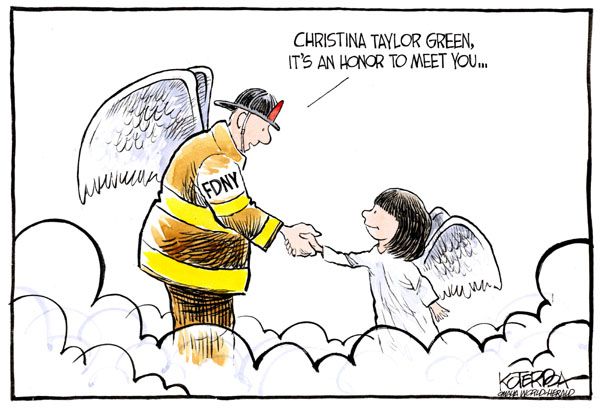
Jeff Koterba, Omaha World Herald, Buy this cartoon
:: ::
A Note About the Diary Poll
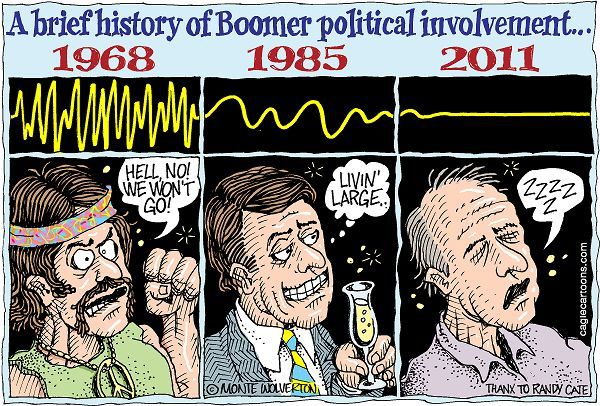
History of Boomer Political Involvement by Monte Wolverton, Cagle Cartoons, Buy this cartoon
:: ::
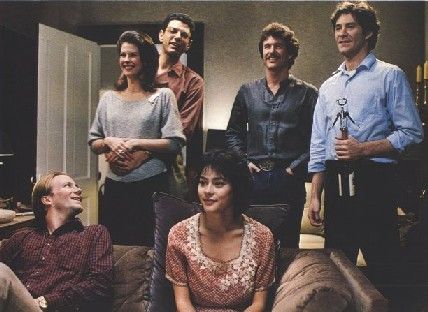
The first wave of the Baby Boomers turned sixty five on January 1, 2011 as I detailed in this recent diary.
Many years after The Big Chill was released in movie theaters, I recall Director Lawrence Kasdan being interviewed on television (it may have been on PBS’ The Charlie Rose Show) in which he was asked as to what he meant by the term “big chill.” Now, most people had assumed that it was a reference to the Baby Boomers (in many instances) “selling out” and ditching their political ideals from the tumultuous 1960’s and 1970’s and as they moved into their thirties, starting families and vigorously engaging in commercial pursuits. Not so, said Kasdan. He explained that the term implied a chilling attitude that a person had towards old friends that he or she may not have seen in years. As you recall, The Big Chill is a movie which involves a reunion of several college friends from the University of Michigan who haven’t seen each other in over a decade. Attending a former classmates’ funeral, the movie details how their lives and social/economic priorities had changed in the intervening years.
Many critics have described The Big Chill as one of the most influential movies about the baby boomers. Though not a complete list, many other movies that may have defined their lives are listed here, here, and here. If you’ve seen any of these movies listed in the diary poll or heard about them, I’d surely like to know more about your impressions.
Remember to take the diary poll.

Loading ...
On this day in 1801, John Marshall is appointed the fourth Chief Justice of the United States. Marshall (September 24, 1755 – July 6, 1835) was an American jurist and statesman whose court opinions helped lay the basis for American constitutional law while enhancing the role of the Supreme Court as a center of power. Marshall was the fourth Chief Justice of the United States, serving from 1801 until his death in 1835. He had served in the United States House of Representatives from 1799 to 1800, and was Secretary of State under President John Adams from 1800 to 1801. Marshall was from the Commonwealth of Virginia and was a leader of the Federalist Party.

 On this day in 1853,
On this day in 1853, 















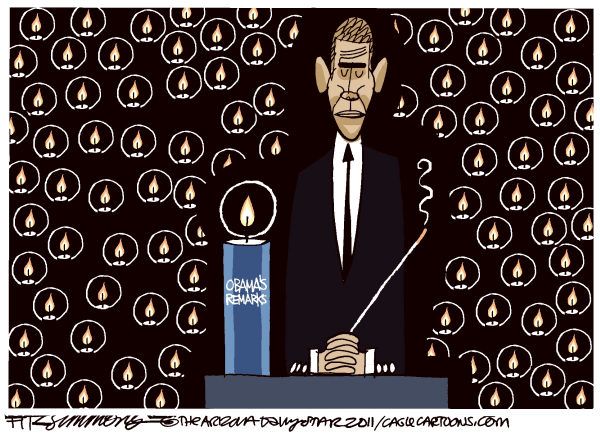






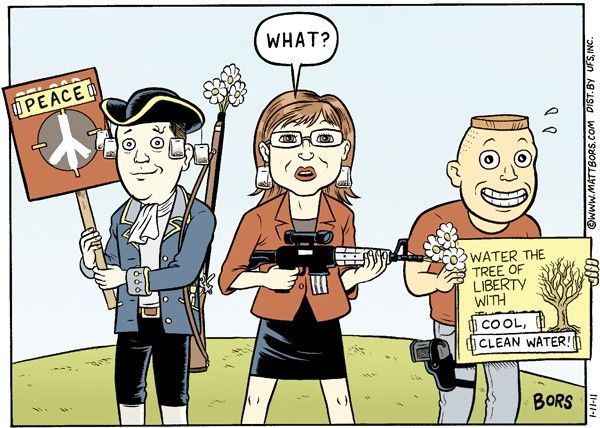








































Recent Comments